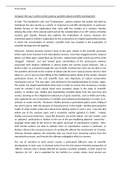Essay
Essay: Compare the ways in which Atwood and Shelley portray anxieties about scientific development in 'Frankenstein' and 'The Handmaid's Tale'
- Course
- Institution
A* Graded practice essay for Pearson Edexcel Unit-2, Prose. This essay compares Shelley and Atwood's portrayal of anxieties about scientific development in their respective novels. Covers all targets, including context and analysis of language.
[Show more]




